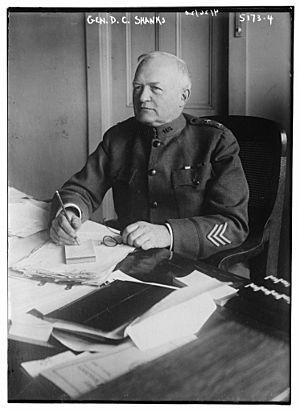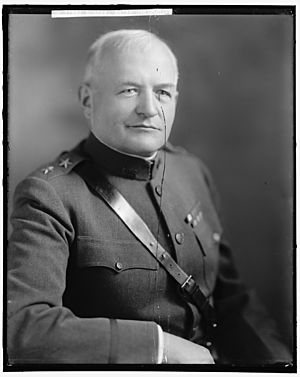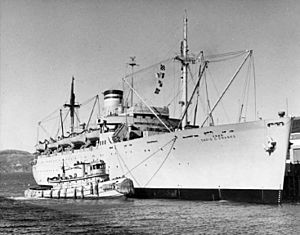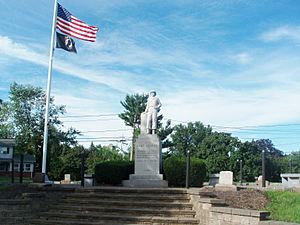David C. Shanks facts for kids
Quick facts for kids
David C. Shanks
|
|
|---|---|

From 1927's As They Passed Through the Port
|
|
| Born | April 6, 1861 Salem, Virginia |
| Died | April 10, 1940 (aged 79) Washington, D.C. |
| Buried | |
| Allegiance | United States |
| Service/ |
United States Army |
| Years of service | 1884-1925 |
| Rank | Major General |
| Unit | U.S. Army Infantry Branch |
| Commands held | Governor of Cavite Hoboken Port of Embarkation 16th Division 5th Division First Corps Area Fort Dix Fourth Corps Area |
| Battles/wars | Spanish–American War Philippine–American War World War I |
| Awards | Army Distinguished Service Medal Navy Distinguished Service Medal |
| Spouse(s) | Nancy Wright Chapman (m. 1893-1940, his death) |
| Children | 2 |
| Relations | Stephen J. Chamberlin (son-in-law) |
David C. Shanks (April 6, 1861 - April 10, 1940) was an important officer in the United States Army. He graduated from the United States Military Academy and became a major general. Shanks fought in the Spanish–American War, the Philippine–American War, and World War I. He was best known for leading the Hoboken Port of Embarkation and the 16th Division during World War I. He also received the Army Distinguished Service Medal and the Navy Distinguished Service Medal.
Contents
Early Life and Education
David Cary Shanks Jr. was born in Salem, Virginia, on April 6, 1861. His parents were David C. Shanks and Sarah Medora (Boone) Shanks. His father was a veteran of the American Civil War and a colonel in the Confederate Army.
Young David went to school in Salem. He then attended Roanoke College, graduating in 1879. After that, he went to the United States Military Academy. He finished his studies there in 1884.
Starting a Military Career
After West Point, Shanks became a second lieutenant in the Infantry. He was assigned to the 18th Infantry Regiment. He served in places like Fort Maginnis, Montana, and Fort Gibson, Oklahoma.
In 1890, he was promoted to first lieutenant. He worked as an adjutant at Fort Clark, Texas. From 1894 to 1898, Shanks taught military science at Virginia Polytechnic Institute.
Serving in the Spanish–American War
When the Spanish–American War began, Shanks helped organize soldiers in Richmond, Virginia. He was in charge of getting Virginia soldiers ready for duty. He worked in Richmond from May 1898 to February 1899.
He was promoted to captain in April 1898. He also became a temporary major in the 2nd Virginia Volunteer Infantry. After the war, he returned to his permanent rank of captain.
The Philippine–American War
In 1899, Shanks rejoined the 18th Infantry. This unit was sent to the island of Panay during the Philippine–American War. Shanks served in the city of Iloilo and stayed in the Philippines until October 1901.
From 1901 to 1903, he served with the 18th Infantry at Fort Douglas, Utah. Later, from 1903 to 1905, Shanks worked with the government in the Philippines. He was the governor of the province of Cavite. In November 1904, he was promoted to major in the 4th Infantry.
Continuing His Service
Shanks served with the 4th Infantry in places like Fort Slocum, New York, and Fort Mackenzie, Wyoming. He returned to the Philippines from 1908 to 1909.
From 1909 to 1912, Shanks worked on recruiting duty in Ohio and Colorado. He became a lieutenant colonel in March 1911. He then served at Fort Thomas, Kentucky.
In 1913, Shanks attended the School for Field Officers in Fort Leavenworth, Kansas. He then became an inspector for the Army. He served in the Inspector General's department. In August 1914, he was promoted to colonel.
From 1915 to 1917, Shanks was an inspector in the Philippine Department. He was promoted to brigadier general in May 1917.
Leadership During World War I
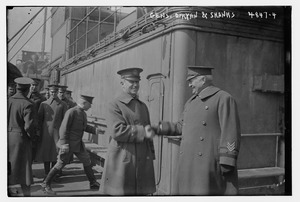
When he came back to the United States, Shanks was put in charge of the Hoboken Port of Embarkation. His job was to plan and manage how Army soldiers and their equipment would be sent to France. He held this important role from July 1917 to September 1918. In August 1917, Shanks became a temporary major general.
After Hoboken, Shanks took command of the 16th Division in Camp Kearny, California. He was still getting his division ready when World War I ended in November 1918. Because the war ended, the 16th Division was no longer needed.
Shanks then returned to the Port of Hoboken. This time, it was a port of debarkation, meaning soldiers and equipment were returning from France. He was in charge of welcoming them back and arranging their travel home. He held this command from December 1918 to April 1920. For his excellent work during the war, Shanks received both the Army Distinguished Service Medal and the Navy Distinguished Service Medal.
After World War I
In April 1920, Shanks was assigned to lead the 5th Division at Camp Gordon, Georgia. He then commanded the First Corps Area in Boston, Massachusetts, until September 1921. In March 1921, he was promoted to permanent major general.
From July to November 1921, Shanks commanded the 1st Division and Fort Dix, New Jersey. In November 1921, he was a pallbearer at the burial of the Unknown Soldier. He also led a board that decided which officers would stay in the Army after World War I.
Shanks commanded the Fourth Corps Area in Atlanta, Georgia, from 1922 to 1924. In August 1923, he was also a pallbearer at the funeral of President Warren G. Harding.
Retirement and Later Life
In January 1925, David C. Shanks retired as a major general. He then lived in Washington, D.C.. He was a writer and published many books and articles. Some of his works include Management of the American Soldier (1918) and As They Passed Through the Port (1927). He also wrote about golf, hunting, and his family history.
Shanks passed away in Washington, D.C., on April 10, 1940. He was buried at Arlington National Cemetery.
Shanks' Legacy
A U.S. military transport ship was named the USNS David C. Shanks (T-AP-180) in his honor. This ship was used to move soldiers and equipment during World War II and the Korean War. It was retired in 1959.
During World War II, the Army also built a military base called Camp Shanks. It was named after Major General Shanks. This camp was located near Orangetown, New York. It was a major center where soldiers got ready to go overseas. After the war, it helped prisoners of war return home. Camp Shanks closed in 1946. Today, there is a museum in Orangetown that remembers Camp Shanks.
In 1921, Roanoke College gave Shanks an honorary degree of LL.D. to recognize his achievements.
Family Life
In October 1893, Shanks married Nancy Wright Chapman (1868-1954). They had two daughters. Their daughter Katherine (1894-1960) married Captain William E. Malloy of the United States Navy. Their other daughter, Sarah (1896-1975), married General Stephen J. Chamberlin.


